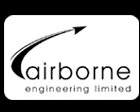Deimos 2 launch successful!
On Thursday, 15th November 2001, 9 members of the MARS flight crew travelled over 400 miles north to a remote private launch site in Scotland for the culmination of the most exciting and ambitious project MARS have ever undertaken.The team's aim was to make the first test launch of the 'Deimos 2' hybrid sounding rocket and with it make the first firing of the B4 hybrid rocket engine which the group has been developing for the last three years.
The vehicle design and motor configuration were set up to reduce the potential altitude of the test launch with the smallest of the MARS manufactured NOx tanks being used on the B4 engine for this flight.
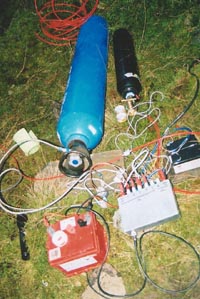 Friday the 16th was spent preparing the 18ft tall rocket for launch at a
cottage, near to the launch site, that was kindly secured for the group by
Andrew Norrie, one of MARS's newest members.
Friday the 16th was spent preparing the 18ft tall rocket for launch at a
cottage, near to the launch site, that was kindly secured for the group by
Andrew Norrie, one of MARS's newest members.
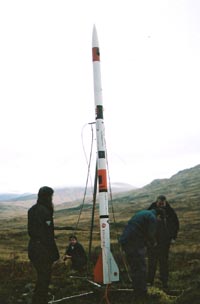 Saturday the 17th was the planned launch day for the rocket however
technical problems in the morning, compounded by deteriorating weather
conditions in the afternoon meant that the launch had to be postponed until
the Sunday.
Saturday the 17th was the planned launch day for the rocket however
technical problems in the morning, compounded by deteriorating weather
conditions in the afternoon meant that the launch had to be postponed until
the Sunday.
Finally, after a very early start for the team, and thanks to some very good organisation, the 60 kg rocket was erected on the launch tower by 9.30am on Sunday the 18th. A launch window was obtained and at just after 10:00am the launch control team began remote filling of the nitrous oxide tank. The on-board vent valve was opened at regular intervals during the fill sequence to keep up the flow rate and determine when the tank was fully filled. After around twenty five minutes of filling the vent valve began releasing plumes of liquid nitrous indicating that the rocket was fully fuelled.
A final radio check was made with all ground stations, then the fill umbilical was remotely released from the rocket.
At approximately 10:40am, a fifteen second terminal countdown was begun over the radio system. At T-4 seconds, the pyrotechnic actuator was ignited, throwing a plume of billowing white smoke and orange flame from the nozzle of the rocket.
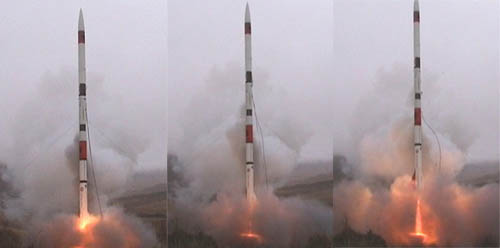
At around T+2 seconds the burst disk actuated and the B4 motor came up to thrust. Due to the cold weather at the launch site and, we believe, due to tank chill-down effects from the frequent venting, the tank was probably only at around 50% - 60% of planned pressure when the motor was ignited. This resulted in the motor thrust being reduced and the burn duration increased.
The rocket lifted majestically off the pad, seven+ mach-diamonds were clearly visible in the exhaust plume as the rocket lifted off as viewed from one of three pad-cams.
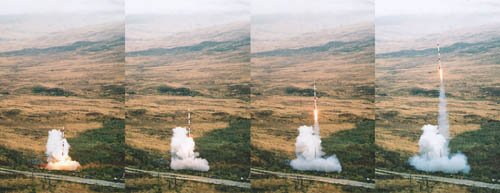
As it ascended with a thunderous roar trailing over five feet of flame, the 18ft rocket slowly picked up speed, as it powered on above the surrounding mountains. For a further five or six seconds the flame of the massive engine could be seen receding into the sky, then just the sound could be heard as the rocket soared in to the distance still under thrust. Effective thrust ended 14.5 seconds after lift off with a further three to four seconds of thrust tail-off.
Apogee occurred around 15 seconds later at an altitude of just under 7000ft whilst the rocket was travelling at relatively high horizontal velocity. This was due to the low thrust to weight ratio caused by the low tank pressure, and a resulting arcing trajectory for the heavy vehicle.
All recovery systems were however deployed, and all sections of the rocket were recovered by a combination of tracking of their onboard RF location beacons and GPS within three hours of launch.
The data recovered from the on-board altimeters so far is promising, showing that despite the massive drop in tank pressure, and resultant low thrust, the motor still achieved at least 90% of predicted Isp and total impulse.
Images from the three on-board video cameras, and two on-board stills cameras, plus the seven ground based cameras and on-board altimeters and accelerometers, are all now being analysed to obtain as much useful information as we can in preparation for future flights of similar large hybrid vehicles.
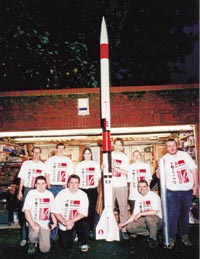 This project was, in all probability, one of the largest, most powerful and
most complex amateur rocket vehicles ever launched in Europe. It is also one
of the largest amateur hybrid rockets ever flight tested anywhere in the
World.
This project was, in all probability, one of the largest, most powerful and
most complex amateur rocket vehicles ever launched in Europe. It is also one
of the largest amateur hybrid rockets ever flight tested anywhere in the
World.
MARS are ecstatic that the project has been so successful and plans are now underway for the next phase of the Deimos programme. One MARS member said of the test: "We now have a fully operational hybrid sounding rocket, space just became a whole lot closer for MARS!"
MARS would like to thank all of our sponsors for helping make the Deimos 2 launch possible, especially the primary sponsors of the Deimos programme, Mission Communications









